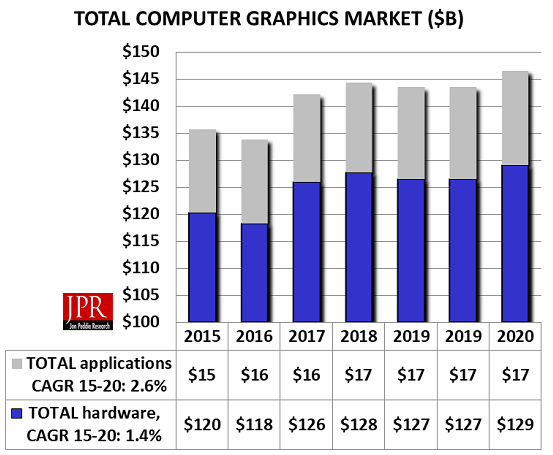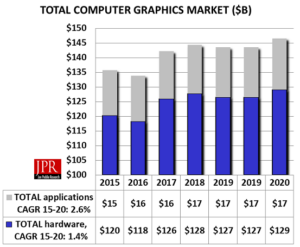Jon Peddie Research (JPR) is forecasting that the overall computer graphics (CG) market will reach $147 billion by 2020, although the industry is slowing to 1% growth for the next few years. The growth is largely influenced by hardware, which has slowed in the past couple of years, but nevertheless there is still growth.
The software aspects of the market have been slow to flat, whereas the hardware segments have been varied, influenced by consumer products such as game consoles. VR is hardly a factor in either hardware or software, and despite some glowing forecasts, it is not believed that it will have much influence in the short term.
The computer graphics hardware market was worth $118 billion in 2015 and is expected to drop to $112 billion by 2019, with software growing slightly better than hardware. The hardware segment of the CG industry has seen steady overall growth, with some variation due to product cycles and the irregularity of the PC market. The largest growth has been in game consoles, gaming PCs, and workstations, with the mobile graphics segment declining due to fewer units being sold and dropping average selling prices due to the very competitive market.

The market for CG software in 2016 was worth $15.5 billion (not counting services, maintenance and other aspects) and is expected to grow to $17.5 billion by 2020 as the industry shifts its sales model moving more services to the cloud, and transitioning to a subscriber system. JPR expects to see the development of traditional segments like CAD/CAM expand as new design approaches in automotive, aerospace, and architecture are adopted. The visualisation market is growing due to the availability of more powerful and less expensive visualisation technologies and also as more customers add design analysis to their portfolio.
The software content creation market has been tough for the market leaders as the market is mature with little growth. However, new opportunities are emerging as new approaches to content creation become practical with new distribution channels opening up, and new technologies such as 3D become popular. Attractive pricing models are emerging, and JPR sees an interesting future for 3D content creation.

The demand for programmers, artists, scientists, and designers continues to be strong and new start-ups arrive in emerging and reborn markets such as AR, VR and casual games. The arrival of new APIs, and platforms are also stimulating development. New opportunities are also growing out of mainstream applications for the web and consumer applications. Social networks are encouraging people to learn new tools, create content for pleasure, and even look for jobs in the field. What used to be a very closed society of experts is now opening up due to the democratisation of CG, fuelled by Moore’s law and price-elasticity due to lower software costs. JPR believes that a new generation of 3D creators is being born as tools become more accessible. Early examples include the Creative edition of Windows, Adobe’s Project Felix, variations on Nvidia’s iRay, and developments using Chaos’ V-Ray SDK.
 The computer graphics market will reach $147 billion by 2020
The computer graphics market will reach $147 billion by 2020

